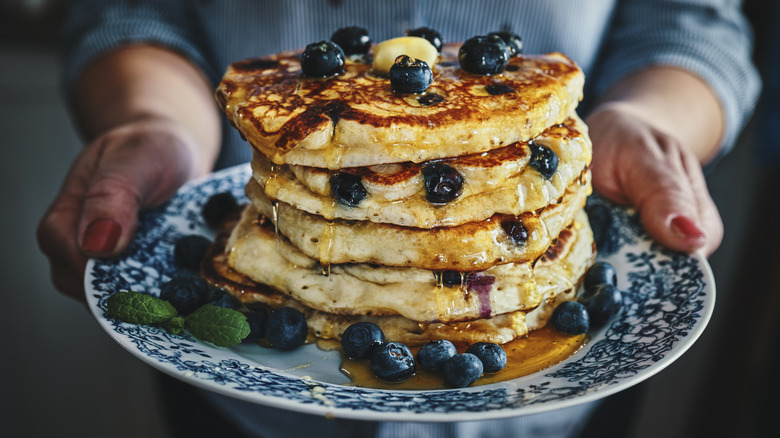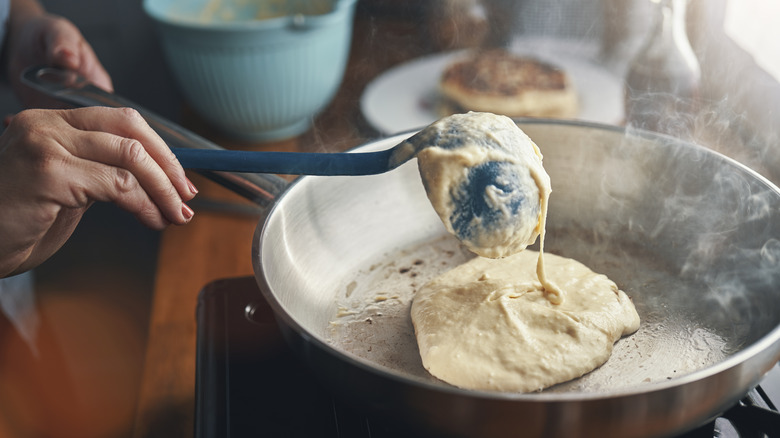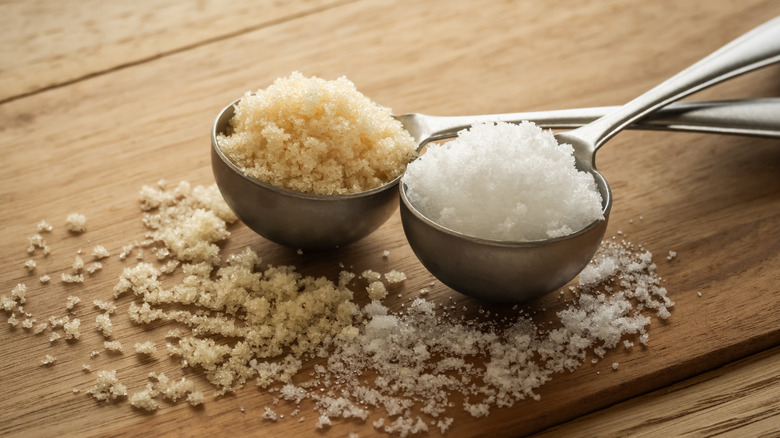You're Making A Mistake By Not Adding Sugar To Pancakes
Whether you want to admit it or not, we're all on team sweet breakfast at the end of the day. It's hard to resist a bite of pancakes when the person sitting next to you at brunch offers them. That especially applies when the pancakes are the perfect fluffy thickness and amber color with a golden-brown rim. Pancakes don't even need to be that sweet because you get to control the amount of maple syrup that goes on top. If you like your pancakes on the less sweet side, however, you might be tempted to cut out the sugar from your recipe altogether. Ultimately, it would be a mistake to not add sugar to your pancake batter, though. Even the smallest amount of sugar matters.
To concoct pancakes you'll want to make every morning, sugar can make all the difference. Sugar is the sole factor in the caramelization process for pancakes. Just a couple tablespoons of sugar in the batter react with the stove's heat to create a golden-brown pancake that's crispy around the edges. The pancake doesn't necessarily need the sweetness. Rather, it needs the extra bit of crunch that takes it from sad and floppy to worthy of soaking up the finest maple syrup. Much like a crème brûlée's caramelized top, pancakes will also benefit from the deep, burnt flavor that caramelized sugar imparts. So, sugar works overtime to do three things at once: provide some light sweetness, a crispy texture, and a deep flavor.
Crispy pancakes are perfect for a decadent brunch
Crispy-edged pancakes have been all the buzz in brunch scenes. Brooklyn restaurant Chez Ma Tante, for example, made a name for itself with its crispy-edged brunch pancakes which have gone viral on TikTok for their "big, crispy rims" and "tender, buttery crumb." A flapjack that's fluffy on the inside and crispy on the outside makes for a textural contrast that's the defining quality of chic brunch pancakes. When recreating these flapjacks at home, a little bit of sugar in the batter is absolutely necessary to achieve a similar effect.
If you really want to bump up your basic homemade pancake recipe on the crispy scale, including sugar and cooking them in butter will give them a fried-food effect. Chez Ma Tante uses sugar in its pancake batter for caramelization and then clarified butter melted on the stove for a delicate, butter-soaked crisp. On their own, these pancakes are so impressive that they do not need to rely on maple syrup for extra flavor or sweetness. Regardless, serving these decadent pancakes up with a healthy drizzle of maple syrup is a requirement and you can't skip the extra pat of butter. These classic pancake toppings will let the delicate texture of the crispy pancakes shine through but that's not to say you shouldn't add more. Fresh fruit like blackberries and blueberries are a good pick for their subtle flavors while fresh raspberry compote will add a tang to balance out the maple syrup.
Brown sugar vs. white sugar in pancakes
When adding sugar to pancake batter, white sugar is the typical pick but not always so. Brown sugar can also help caramelize the edges of your pancakes (all sugars work the same). However, the flavors they impart can impact your decision. White, a.k.a. granulated sugar is the basic result of a sugar cane refining and purifying process. Brown sugar goes through the same process but gains its unique qualities with one added ingredient: molasses. You can even make brown sugar from white sugar if you have molasses on hand at home. Molasses give the sugar its brown color, sand-like texture, and depth of flavor. When tasting white sugar, it's hard to pinpoint flavors beyond "sweet" but brown sugar has a toffee-like richness that translates to baked goods with extra flavor.
However, this extra flavor from brown sugar is not necessarily better. It is all up to personal preference which sugar you choose to add to pancakes. White sugar is neutral, hence perfect for those who want a straightforward pancake. This flavor deepens as the sugar carmelizes and cooks, but is still lighter than brown sugar. Brown sugar is a good pick for a slightly unconventional pancake that doesn't stray too far from the original. A brown sugar pancake will have a nutty richness that further develops into a butterscotch-like flavor once the pancake is cooked and the sugar is caramelized. Brown sugar and white sugar are equally respectable choices for a crispy-edged pancake.


